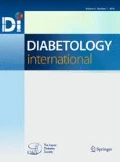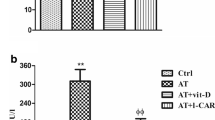Abstract
Aim
Fenofibrate (FF) is known to block ATP synthesis in mitochondria by inhibiting electron transport at NADH–ubiquinone (UQ) oxidoreductase (complex I) in the respiratory chain.
Methods
Toxicity to mitochondria of bezafibrate (BF) was compared with that of FF, focusing exclusively on their effects on impairment of the electron-transport and energy-transfer systems in oxidative phosphorylation, by experiments with isolated rat liver mitochondria and submitochondrial particles (SMP).
Results
FF and BF had an uncoupling effect, enhancing ATP hydrolytic activity (latent ATPase) in mitochondria. DNP-stimulated ATPase activity was not suppressed by either agent, indicating no interference with the energy-transfer system. Both reagents inhibited NAD-linked respiration but did not affect succinate-linked respiration, indicating specific inhibition of electron-transport activity in complex I. NADH oxidase in SMP was strongly inhibited by FF, and activity was recovered by treatment with tetramethyl-p-phenylenediamine, indicating that the site of inhibition is not located at the NADH dehydrogenase portion but at the UQ site in complex I. Uncoupling and electron-transport inhibition by BF were noticeably weaker than those by FF.
Conclusions
From these results it was concluded that BF and FF were toxic to mitochondria through the dual actions of an uncoupling effect and electron-transport inhibition. The toxicity of BF to mitochondrial function was found to be noticeably weaker than that of FF, implying that BF might be much less toxic than FF for long term in-vivo use as an antihyperlipidemic agent.






Similar content being viewed by others
References
Rajamani K, Colman PG, Li L-P, Best JD, Voysey M, D’Emden MC, Laakso M, Baker JR, Keech AC, on behalf of the FIELD study investigators. Effect of fenofibrate on amputation events in people with type 2 diabetes mellitus (FIELD study): a prespecified analysis of a randomized controlled trial. Lancet. 2009;373:1780–8.
The BIP study group. Secondary prevention by raising HDL cholesterol and reducing triglycerides in patients with coronary artery disease. The bezafibrate infarction prevention (BIP) Study. Circulation. 2000;102:21–7.
Balfour JA, McTavish D, IIeel RC. Fenofibrate. A review of its pharmacodynamics and pharmacokinetic properties and therapeutic use in dyslipidemia. Drugs. 1990;40:260–90.
Kobayashi M, Shigeta Y, Hirata Y, Omori Y, Sakamoto N, Nambu S, Baba S. Improvement of glucose tolerance in NIDDM by clofibrate. Randomized double-blind study. Diabetes Care. 1988;11:495–9.
Lee HJ, Choi SS, Park MK, An YJ, Seo SY, Kim MC, Hong SH, Hwang TH, Kang DY, Garber AJ. Fenofibrate lowers abdominal and skeletal adiposity and improves insulin sensitivity in OLETF rats. Biochem Biophs Res Commun. 2002;296:293–9.
Lee CH, Olson P, Evans RM. Minireview: lipid metabolism, metabolic disease and peroxisome proliferator-activated receptors. Endocrinology. 2003;144:2201–7.
Zou S, Wallace KB. The effect of peroxisome proliferators on mitochondrial bioenergetics. Toxicol Sci. 1999;48:82–9.
Brunmair B, Lest A, Staniek K, Gras F, Scharf N, Roden M, Nohl H, Werner Waldhausl W, Furnsinn C. Fenofibrate impairs rat mitochondrial function by inhibition of respiratory complex I. J Pharmacol Exp. 2004;311:109–14.
Erecinska M, Wilson DF. Inhibitors of mitochondrial function. Oxford: Pergamon Press; 1981.
Schuneider WC. Intracellular distribution of enzymes III. The oxidation of octanoic acid by rat liver fractions. J Biol Chem. 1948;176:259–66.
Ruzicka HJ, Crane F. Quinone interaction with the respiratory chain-linked NADH dehydrogenase of beef heart mitochondria. I. Juglone reductase activity. Biochim Biophys Acta. 1970;223:71–85.
Chance B, Williams GR. Respiratory enzymes and oxidative phosphorylation. J Biol Chem. 1955;219:383–438.
Lowry OH, Rosebrough NJ, Farr AL, Randall RJ. Protein measurement with the Folin phenol reagent. J Biol Chem. 1951;143:265–75.
Tenenbaum A, Motro M, Fisman EZ, Schwammenthal E, Adler Y, Goldenberg I, Leor J, Boyko V, Mandelzweig L, Behar S. Peroxisome proliferator-activated receptor ligand bezafibrate for prevention of type 2 diabetes mellitus in patients with coronary artery disease. Circulation. 2004;109:2197–202.
Tenebaum A, Fisman EZ, Boyko V, Benderly M, Tanne d, Haim M, Matas Z, Motro M, Behar S. Attenuation of progression of insulin resistance in patients with coronary artery disease by bezafibrate. Arch Intern Med. 2006;166:737–41.
Author information
Authors and Affiliations
Corresponding author
About this article
Cite this article
Yamada, K., Tsunoda, K., Kawai, K. et al. Mitochondria toxicity of antihyperlipidemic agents bezafibrate and fenofibrate. Diabetol Int 4, 126–131 (2013). https://doi.org/10.1007/s13340-012-0104-9
Received:
Accepted:
Published:
Issue Date:
DOI: https://doi.org/10.1007/s13340-012-0104-9




